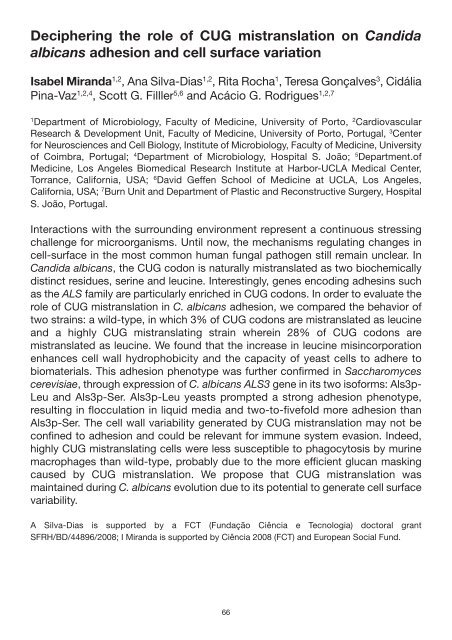Candida Infection Biology – fungal armoury, battlefields ... - FINSysB
Candida Infection Biology – fungal armoury, battlefields ... - FINSysB
Candida Infection Biology – fungal armoury, battlefields ... - FINSysB
Create successful ePaper yourself
Turn your PDF publications into a flip-book with our unique Google optimized e-Paper software.
Deciphering the role of CUG mistranslation on <strong>Candida</strong><br />
albicans adhesion and cell surface variation<br />
Isabel Miranda 1,2 , Ana Silva-Dias 1,2 , Rita Rocha 1 , Teresa Gonçalves 3 , Cidália<br />
Pina-Vaz 1,2,4 , Scott G. Filller 5,6 and Acácio G. Rodrigues 1,2,7<br />
1 Department of Microbiology, Faculty of Medicine, University of Porto, 2 Cardiovascular<br />
Research & Development Unit, Faculty of Medicine, University of Porto, Portugal, 3 Center<br />
for Neurosciences and Cell <strong>Biology</strong>, Institute of Microbiology, Faculty of Medicine, University<br />
of Coimbra, Portugal; 4 Department of Microbiology, Hospital S. João; 5 Department.of<br />
Medicine, Los Angeles Biomedical Research Institute at Harbor-UCLA Medical Center,<br />
Torrance, California, USA; 6 David Geffen School of Medicine at UCLA, Los Angeles,<br />
California, USA; 7 Burn Unit and Department of Plastic and Reconstructive Surgery, Hospital<br />
S. João, Portugal.<br />
Interactions with the surrounding environment represent a continuous stressing<br />
challenge for microorganisms. Until now, the mechanisms regulating changes in<br />
cell-surface in the most common human <strong>fungal</strong> pathogen still remain unclear. In<br />
<strong>Candida</strong> albicans, the CUG codon is naturally mistranslated as two biochemically<br />
distinct residues, serine and leucine. Interestingly, genes encoding adhesins such<br />
as the ALS family are particularly enriched in CUG codons. In order to evaluate the<br />
role of CUG mistranslation in C. albicans adhesion, we compared the behavior of<br />
two strains: a wild-type, in which 3% of CUG codons are mistranslated as leucine<br />
and a highly CUG mistranslating strain wherein 28% of CUG codons are<br />
mistranslated as leucine. We found that the increase in leucine misincorporation<br />
enhances cell wall hydrophobicity and the capacity of yeast cells to adhere to<br />
biomaterials. This adhesion phenotype was further confirmed in Saccharomyces<br />
cerevisiae, through expression of C. albicans ALS3 gene in its two isoforms: Als3p-<br />
Leu and Als3p-Ser. Als3p-Leu yeasts prompted a strong adhesion phenotype,<br />
resulting in flocculation in liquid media and two-to-fivefold more adhesion than<br />
Als3p-Ser. The cell wall variability generated by CUG mistranslation may not be<br />
confined to adhesion and could be relevant for immune system evasion. Indeed,<br />
highly CUG mistranslating cells were less susceptible to phagocytosis by murine<br />
macrophages than wild-type, probably due to the more efficient glucan masking<br />
caused by CUG mistranslation. We propose that CUG mistranslation was<br />
maintained during C. albicans evolution due to its potential to generate cell surface<br />
variability.<br />
A Silva-Dias is supported by a FCT (Fundação Ciência e Tecnologia) doctoral grant<br />
SFRH/BD/44896/2008; I Miranda is supported by Ciência 2008 (FCT) and European Social Fund.<br />
66


